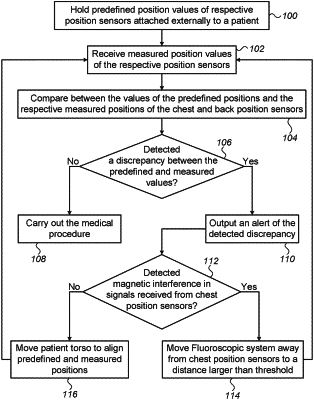| CPC A61B 34/20 (2016.02) [A61B 5/6852 (2013.01); A61B 18/1492 (2013.01); A61B 5/0215 (2013.01); A61B 2018/00392 (2013.01); A61B 2018/00869 (2013.01); A61B 2034/2046 (2016.02); A61B 2090/367 (2016.02); A61B 2090/378 (2016.02)] | 20 Claims |

|
1. A system for correcting map shifting, comprising:
a processor, which is configured to:
receive electrical signals indicative of measured positions of one or more chest position sensors configured to be attached externally to a chest of a patient, and one or more back position sensors configured to be attached externally to a back of the patient;
compare at least one of (i) the respective measured positions and predefined positions of the one or more chest position sensors, or (ii) the respective measured positions and predefined positions of the one or more back position sensors;
cause an alert to be displayed on an output device in response to detecting a discrepancy between at least one of (i) the respective measured and predefined positions of the one or more chest position sensors, or (ii) the respective measured and predefined positions of the one or more back position sensors;
determine whether magnetic interference from an anatomical imaging system is detected in the electrical signals received by the one or more chest position sensors;
reposition, in response to detecting magnetic interference, the anatomical imaging system away from the one or more chest position sensors until the detected magnetic interference is within an allowable magnitude;
reposition the patient to align at least one of the measured positions and predefined positions of the: i) one or more chest position sensors, or ii) the one or more back position sensors, in response to detecting the discrepancy;
compare, when no magnetic interference is detected or the detected magnetic interference is within an allowable magnitude, received additional electrical signals indicative of measured positions of the one or more chest position sensors and the one or more back position sensors after repositioning the patient until there is no discrepancy.
|